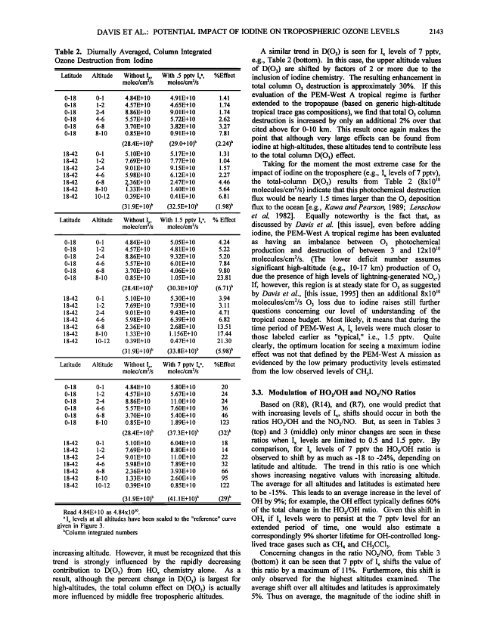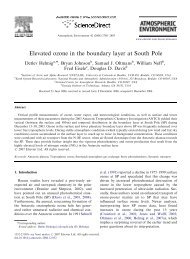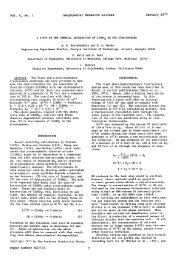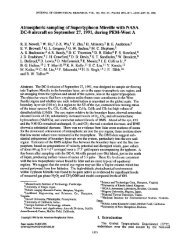View PDF - Doug Davis - Georgia Institute of Technology
View PDF - Doug Davis - Georgia Institute of Technology
View PDF - Doug Davis - Georgia Institute of Technology
You also want an ePaper? Increase the reach of your titles
YUMPU automatically turns print PDFs into web optimized ePapers that Google loves.
DAVIS ET AL.: POTENTIAL IMPACT OF IODINE ON TROPOSPHERIC OZONE LEVELS 2143Table 2. Diurnally Averaged, Column IntegratedOzone Destruction from IodineLatitude Altitude Without Ix, With .5 pptv Ix a, %Effectmolec/cm2/s molec/cm2/s0-18 0-1 4.84E+ 10 4.91E+ 10 1.410-18 1-2 4.57E+ 10 4.65E+ 10 1.740-18 2-4 8.86E+ 10 9.01E+ 10 1.740-18 4-6 5.57E+ 10 5.72E+ 10 2.620-18 6-8 3.70E+ 10 3.82E+ 10 3.270-18 8-10 0.85E+10 0.91E+10 7.81(28.4E+ 10) b (29.0+ 10) b (2.24) b18-42 0-1 5.10E+10 5.17E+10 1.3118-42 1-2 7.69E+10 7.77E+10 1.0418-42 2-4 9.01E+10 9.15E+10 1.5718-42 4-6 5.98E+10 6.12E+10 2.2718-42 6-8 2..36E+10 2.47E+10 4.4618-42 8-10 1.33E+10 1.40E+10 5.6418-42 10-12 0.39E+10 0.41E+10 6.81(31.9E+10) b(32.5E+10) b (1.98) bLatitude Altitude Without I•, With 1.5 pptv I• a, % Effectmolec/cm2/s molec/cm2/s0-18 0-1 4.84E+ 10 5.05E+ 10 4.240-18 1-2 4.57E+10 4.81E+10 5.220-18 2-4 8.86E+ 10 9.32E+ 10 5.200-18 4-6 5.57E+ 10 6.01 E+ 10 7.840-18 6-8 3.70E+ 10 4.06E+ 10 9.800-18 8-10 0.85E+10 1.05E+10 23.81(28.4E+10) b(30.3E+10) b (6.71) b18-42 0-1 5.10E+10 5.30E+10 3.9418-42 1-2 7.69E+10 7.93E+10 3.1118-42 2-4 9.01E+10 9.43E+10 4.7118-42 4-6 5.98E+10 6.39E+10 6.8218-42 6-8 2.36E+10 2.68E+10 13.5118-42 8-10 1.33E+10 1.156E+10 17.4418-42 10-12 0.39E+10 0.47E+10 21.30(31.9E+ 10) b(33.8E+ 10) b (5.98) bLatitude Altitude Without Ix, With 7 pptv I• a, %Effectmolec/cm2/s molec/cm2/s0-18 0-1 4.84E+ 10 5.80E+ 10 200-18 1-2 4.57E+10 5.67E+10 240-18 2-4 8.86E+ 10 11.0E+ 10 240-18 4-6 5.57E+ 10 7.60E+ 10 360-18 6-8 3.70E+ 10 5.40E+ 10 460-18 8-10 0.85E+10 1.89E+10 123(28.4E+10) b(37.3E+10) b(32) b18-42 0-1 5.10E+10 6.04E+10 1818-42 1-2 7.69E+ 10 8.80E+ 10 1418-42 2-4 9.01E+10 11.0E+10 2218-42 4-6 5.98E+10 7.89E+10 3218-42 6-8 2.36E+10 3.93E+10 6618-42 8-10 1.33E+10 2.60E+10 9518-42 10-12 0.39E+10 0.85E+10 122(31.9E+10) b(41.1E+10) b(29) bRead 4.84E+10 as 4.84xl 010o• I• levels at all altitudes have been scaled to the "reference" curvegiven in Figure 3.bColumn integrated numbersincreasing altitude. However, it must be recognized that thistrend is strongly influenced by the rapidly decreasingcontribution to D(O3) from HOx chemistry alone. As aresult, although the percent change in D(O3) is largest forhigh-altitudes, the total column effect on D(O3) is actuallymore influenced by middle free tropospheric altitudes.A similar trend in D(O3) is seen for I• levels <strong>of</strong> 7 pptv,e.g., Table 2 (bottom). In this case, the upper altitude values<strong>of</strong> D(O3) are shifted by factors <strong>of</strong> 2 or more due to theinclusion <strong>of</strong> iodine chemistry. The resulting enhancement intotal column 03 destruction is approximately 30%. If thisevaluation <strong>of</strong> the PEM-West A tropical regime is furtherextended to the tropopause (based on generic high-altitudetropical trace gas compositions), we find that total 03 columndestruction is increased by only an additional 2% over thatcited above for 0-10 kin. This result once again makes thepoint that although very large effects can be found fromiodine at high-altitudes, these altitudes tend to contribute lessto the total column D(O3) effect.Taking for the moment the most extreme case for theimpact <strong>of</strong> iodine on the troposphere (e.g., I• levels <strong>of</strong> 7 pptv),the total-column D(O3) results from Table 2 (Sx10 lømolecules/cm2/s) indicate that this photochemical destructionflux would be nearly 1.5 times larger than the 03 depositionflux to the ocean [e.g., Kawa and Pearson, 1989; Lenschowet al, 1982]. Equally noteworthy is the fact that, asdiscussed by <strong>Davis</strong> et al. [this issue], even before addingiodine, the PEM-West A tropical regime has been evaluatedas having an imbalance between 03 photochemicalproduction and destruction <strong>of</strong> between 3 and 12x10 lømolecules/cm2/s. (The lower deficit number assumessignificant high-altitude (e.g., 10-17 km) production <strong>of</strong> 03due the presence <strong>of</strong> high levels <strong>of</strong> lightning-generated NOx.)If, however, this region is at steady state for 03 as suggestedby <strong>Davis</strong> et al., [this issue, 1995] then an additional 8x10 lømolecules/cm2/s 03 loss due to iodine raises still furtherquestions concerning our level <strong>of</strong> understanding <strong>of</strong> thetropical ozone budget. Most likely, it means that during thetime period <strong>of</strong> PEM-West A, I• levels were much closer tothose labeled earlier as "typical," i.e., 1.5 pptv. Quiteclearly, the optimum location for seeing a maximum iodineeffect was not that defined by the PEM-West A mission asevidenced by the low primary productivity levels estimatedfrom the low observed levels <strong>of</strong> CH3I.3.3. Modulation <strong>of</strong> HO2/OH and NO2/NO RatiosBased on (R8), (R14), and (R7), one would predict thatwith increasing levels <strong>of</strong> Ix, shifts should occur in both theratios HO2/OH and the NO2/NO. But, as seen in Tables 3(top) and 3 (middle) only minor changes are seen in theseratios when I x levels are limited to 0.5 and 1.5 pptv. Bycomparison, for I• levels <strong>of</strong> 7 pptv the HO2/OH ratio isobserved to shift by as much as-18 to -24%, depending onlatitude and altitude. The trend in this ratio is one whichshows increasing negative values with increasing altitude.The average for all altitudes and latitudes is estimated hereto be -15%. This leads to an average increase in the level <strong>of</strong>OH by 9%; for example, the OH effect typically defines 60%<strong>of</strong> the total change in the HO2/OH ratio. Given this shift inOH, if I• levels were to persist at the 7 pptv level for anextended period <strong>of</strong> time, one would also estimate acorrespondingly 9% shorter lifetime for OH-controlled longlivedtrace gases such as CH4 and CH3CC13.Concerning changes in the ratio NO2/NO, from Table 3(bottom) it can be seen that 7 pptv <strong>of</strong> I• shifts the value <strong>of</strong>this ratio by a maximum <strong>of</strong> 11%. Furthermore, this shift isonly observed for the highest altitudes examined. Theaverage shift over all altitudes and latitudes is approximately5%. Thus on average, the magnitude <strong>of</strong> the iodine shift in






